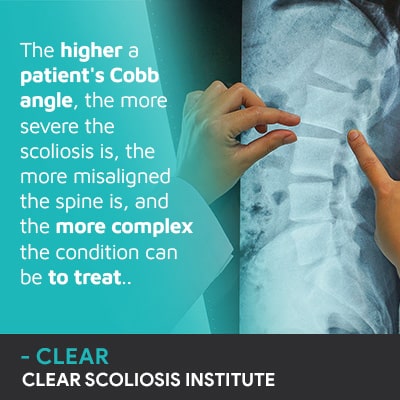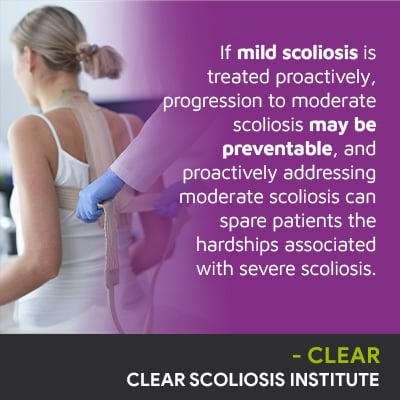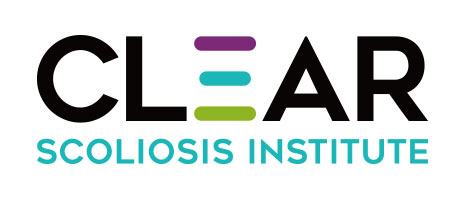
Not only are there different types of scoliosis, the condition ranges widely in severity. Scoliosis cases also vary based on patient age and curvature location. With so many different factors shaping a patient's condition, treatment plans have to be 100-percent customized.
Understanding the severity levels of scoliosis is important because they range widely, and as a progressive spinal condition, its nature is to become more severe over time. Condition severity ranges from mild to moderate, severe and very severe and is determined by a measurement known as Cobb angle.
Scoliosis is not a static condition, so the severity level at the time of diagnosis doesn't mean that's where it will stay.
A scoliosis diagnosis means the spine has an unnatural lateral (side-to-side) curvature.
A healthy spine is curved at each of its main sections, and these curves work together to make the spine more flexible, better at handling mechanical stress, stronger, and less vulnerable to injury.
And as the brain depends on the nerves within the spine to communicate with the rest of the body, spinal conditions capable of disrupting nerve-function can cause a variety of symptoms felt throughout the body and should always be taken seriously.
When scoliosis is first diagnosed, it's classified around important condition variables so treatment plans can be crafted accordingly.
The complex and progressive nature of scoliosis necessitates the individualization of treatment plans.
Scoliosis can't be officially diagnosed without an X-ray; a scoliosis X-ray is needed to confirm that the unnatural sideways-bending curve includes rotation, and to determine condition severity via the patient's Cobb angle measurement.
Condition severity is based on this measurement, and it involves lines being drawn from the tops and bottoms of the vertebrae at the curve's apex (the most unnaturally tilted); the lines form an angle that's measured in degrees.

Mild scoliosis is diagnosed with a Cobb angle of between 10 and 25 degrees.
To be considered scoliosis, the spine has to bend to the side, rotate, and have a minimum Cobb angle measurement of 10 degrees.
What's most important to understand about the degrees of scoliosis is that conditions can, and most likely, will change.
In most cases of scoliosis, we don't know what causes their initial onset, but we know what causes progression: growth.
Scoliosis progression involves the unhealthy spinal curvature getting larger, and this makes the spine more rigid and the condition more difficult to correct, hence the benefit of starting treatment while conditions are mild.
However, most cases of scoliosis are diagnosed when enough progression has occurred that the often subtle signs of mild scoliosis are replaced by the more-overt symptoms associated with moderate and severe scoliosis.
In children, the earliest signs of scoliosis involve postural changes such as the development of uneven shoulders with one shoulder blade protruding more on one side and one shoulder sitting higher than the opposite side, but when mild, these changes can be difficult to detect.
There are a lot of advantages to an early diagnosis of mild scoliosis because this is when the condition is at its mildest, the spine will be at its most flexible; this is the best time to start active treatment.
Most patients are diagnosed with moderate scoliosis because it's when mild scoliosis becomes moderate that noticeable symptoms develop.
Moderate scoliosis is diagnosed with Cobb angle measurements of between 25 and 40 degrees.
The signs of moderate scoliosis are more noticeable because progression has occurred, and increasing postural changes can include uneven shoulders and hips, the development of a rib cage arch, and an uneven waist.
In adult scoliosis, the main symptom is pain caused by compression; scoliosis doesn't become compressive until growth has stopped, so while pain management is a focus when treating adult scoliosis, it's not commonly a focus of childhood scoliosis treatment.

There are never treatment guarantees, but not proactively addressing scoliosis can mean wasting valuable treatment time.
In addition to postural changes, disruptions to movement (balance, coordination, and gait) are also symptoms of moderate and severe scoliosis.
Severe scoliosis is diagnosed with Cobb angle measurements of 40+ degrees.
Once severe, the symptoms of scoliosis are overt and difficult to miss, and if a patient with severe scoliosis has committed to a traditional treatment approach, this commonly involves an invasive surgical procedure: spinal fusion surgery.
Severe cases are more complex to treat because the curves are larger, the spine is more twisted and rigid, and significant progression has occurred, making the condition's effects more established and difficult to improve and/or reverse.
Spinal fusion surgery will shape the spine's long-term strength, function, and health, and common effects include a spine that's less flexible with a reduced range of motion, increased pain at the fusion site, and a spine that's weaker and more susceptible to injury.
While each patient's response to scoliosis surgery will be unique, a spine that's fused is fused for life, and hardware used to hold the spine in place (metal rods and pedicle screws) can malfunction over time, meaning more surgery with increasing risks.
What's important to understand is that once scoliosis becomes severe, non-surgical treatment options become less effective, but when applied early and addressed proactively, scoliosis can be highly treatable, and many patents don't need surgical intervention.
So for those wanting to address their scoliosis proactively, or try a more natural and less invasive treatment option than surgery, there are multiple modern conservative scoliosis treatment disciplines.
Here at the CLEAR Scoliosis Institute, conservative treatment is applied immediately following a diagnosis in the hopes of preventing progression and the need for invasive spinal surgery.
Conservative treatment is integrative so patients of the Institute benefit from what chiropractic care, physical therapy, a variety of therapies, the prescription of scoliosis-specific exercises, bracing when appropriate, and rehabilitation can offer.
As a structural spinal condition, the underlying structural nature has to be addressed on a structural level, and this is worked towards through a variety of chiropractic adjustments with potential to reduce the curve size by repositioning the curve's most-tilted vertebrae into a straighter alignment.
Structural changes have to be supported, and physical therapy is applied to strengthen the spine's surrounding muscles for more support and stability.
In addition to postural changes, movement changes, and pain, scoliosis can also cause a muscular imbalance as the unnatural spinal curve pulls its surrounding muscles in different directions.
The uneven forces of scoliosis don't just affect the spine and its surrounding muscles and nerves; the effects of a misaligned spine can be felt from the head to the feet.
Corrective bracing can help push the spine into a straighter alignment, and as growing spines are more flexible, it's particularly helpful for patients who have not yet reached skeletal maturity.
Regardless of a patient's degree of scoliosis at the time of diagnosis, as a progressive condition triggered by growth, it's likely to change over time and during growth spurts.
An abnormal curvature of the spine should always be taken seriously and treated proactively as increasing scoliosis degrees means increasing symptoms of scoliosis such as postural changes, and this can also mean more invasive treatment options are necessary.
Scoliosis is an ongoing condition, so treatment will shape the spine's current and future health and function.
The best way to minimize and/or prevent related symptoms of scoliosis is to treat it proactively, and conservative treatment has the potential to stop progression, reduce the degree of scoliosis, and prevent crossing the surgical threshold.
Conservative non-surgical treatment is also known as functional treatment because a functional treatment approach addresses scoliosis while preserving as much of the spine's natural function and strength as possible; while spinal fusion surgery can straighten a bent spine, the methodology can cost the spine in flexibility, strength, and function.
The difference between the two main scoliosis treatment approaches needs to be understood so informed treatment choices can be made, and while there are no treatment guarantees, scoliosis diagnosed early in its progressive line and treated proactively can be highly responsive.
The degree of curvature is determined by a patient's Cobb angle measurement, and this is how scoliosis is classified as mild, moderate, or severe, and treatment plans are shaped around condition severity and a number of other key variables.

CLEAR provides a unique and innovative way of understanding scoliosis. Sign up to receive facts and information you won’t find anywhere else.
